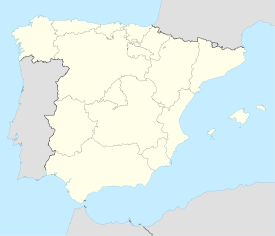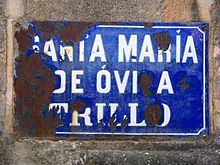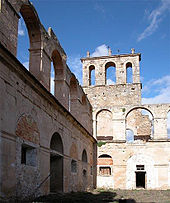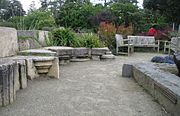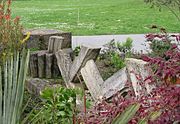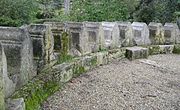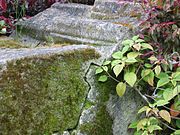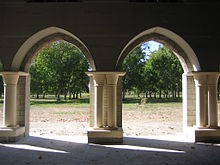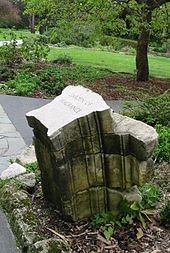- Santa Maria de Ovila
-
Santa María de Óvila 
Ruins of Santa María de Óvila in Spain
Basic information Location  Trillo, Guadalajara, Castile-La Mancha, Spain
Trillo, Guadalajara, Castile-La Mancha, SpainGeographic coordinates 40°42′03″N 2°33′26″W / 40.7008°N 2.5572°WCoordinates: 40°42′03″N 2°33′26″W / 40.7008°N 2.5572°W Affiliation Roman Catholic Church Year consecrated 1213 Ecclesiastical or organizational status Monastery Status Abandoned Architectural description Architectural type Monastery, Church Architectural style Gothic, Renaissance Groundbreaking 1181 Completed 1213 Santa María de Óvila is a former Cistercian monastery built in Spain in the 13th century on the Tagus River near Trillo, Guadalajara; about 90 miles (140 km) northeast of Madrid. During prosperous times over the next four centuries, construction projects expanded and improved the monastery. Its fortunes declined significantly in the 1700s, and in 1835 it was confiscated by the Spanish government and sold to private owners who used its buildings to shelter farm animals.
American millionaire William Randolph Hearst bought parts of the monastery in 1931 with the intention of using its stones in the construction of a grand and fanciful castle at Wyntoon in California, but after some 10,000 stones were removed and shipped, they were abandoned in San Francisco for decades. These stones are now in various locations around California: some are reassembled at the University of San Francisco, others are serving as simple decorative elements in Golden Gate Park's botanical garden, and some are being reassembled by Trappist monks at the Abbey of New Clairvaux in Vina. A line of Belgian-style beers is being produced by Sierra Nevada Brewing Company under the Ovila Abbey brand to support the reconstruction project.
In Spain, the new government of the Second Republic declared the monastery a National Monument in June 1931, but not in time to prevent the mass removal of stones. Today, the original ruins are on the grounds of a private farm.
Contents
History
Foundation
The monastery of Santa Maria de Ovila was initiated in 1175 by a grant from King Alfonso VIII of Castile, awarded to monks from Valbuena Abbey located in Valbuena de Duero, Valladolid Province, Castile-Leon, Spain. In this endeavor, the king was following a general strategy of establishing Catholic institutions in land he had recently won in battle from the Moors of Iberia.[1] The Cistercian "white monks" (wearing undyed habits) first chose a site in Murel (now called Carrascosa de Tajo) on the Tagus but soon relocated a few miles nearer to Trillo, Guadalajara, where a flat hilltop by the river commanded a modest view.[2]
Construction began in 1181. The abbey, the monastic quarters, the cloister and the church were built over three decades. Some of the buildings were given seven-foot-thick (2 m) walls with slit windows, to serve as a refuge in case of renewed attack by the Moors.[3] The aged abbot of Santa María de Huerta, bishop Martin de Finojosa (later sainted), consecrated the chapel in September 1213 and died days later.[4] The surrounding area of Murel and Trillo along the Tagus prospered, giving tithes and gifts of land to the monastery. Alfonso VIII declared that the monastery was free of royal tariffs, allowing the monks to cut wood in the royal forest, and their cattle to graze on the king's land.
The first buildings were completed in the Gothic style, including the chapel. The refectory (dining hall) shows an architecture in transition between earlier Romanesque and contemporary Gothic.[3] Somewhat later, or perhaps at the same time,[3] a fine High Gothic chapter house was built of best quality hard limestone cut very neatly. The chapel was rebuilt in late Gothic style with a prominent vaulted ceiling. The cloister was rebuilt around 1617, and is a simple design with little adornment surrounding a High Renaissance arcade. The final building project took place around 1650: a new doorway for the church, completed in late Renaissance and Plateresque style full of detail.[3] Because of its prosperity and the repeated expansion projects, Santa María de Óvila contained examples of every Spanish religious architectural style used from 1200 to 1600.[4]
Decline
From the 15th century Santa María de Óvila began a slow decline. Civil wars gradually depopulated the villages of the upper Tagus valley. The monastery's land holdings passed one by one into the hands of the new regional aristocracy: first the Count of Cifuentes, followed by Rui Gomes da Silva, Duke of Pastrana, and by the Spanish Army. Neighbors looted more lands.[5]
The precarious situation of the monastery was worsened in the 18th century by a fire which destroyed part of the monastery during the War of the Spanish Succession. Subsequent wars caused considerable losses and major economic damage to the property. In the early 19th century, the nearby villagers denied support to the monastery despite its protection by King Ferdinand VII. The fatal blow came in 1835: the Ecclesiastical Confiscations of Mendizábal worked under the rule that minor religious holdings housing less than 12 residents were to be forfeited to the state; the monastery had only four monks and one lay brother.[3][4] They were cast out.[1]
Vacancy
After the Confiscations, many of the furnishings and artistic treasures of Santa María de Óvila passed to the surrounding parish churches, especially Ruguilla, Huet, Sotoca de Tajo and Carrascosa de Tajo. Other valuables such as books and historic documents were stolen and sold. The remaining contents were auctioned, including wine making equipment and an oxcart.[4] The cartulary of the monastery, a thick manuscript holding copies of royal privileges granted to the monastery in the Middle Ages, went to a private owner. The Abadologio, a comprehensive and thorough history of the Cistercian monks who lived in the monastery, is carefully kept at the Monastery of Santa María la Real of Oseira. The new owners of Santa Maria de Ovila were well-to-do farmers who cared little for the buildings. For a brief time, the former monastery was used as a hostel, but mainly, the buildings were subjected to hard agricultural use as barns sheltering livestock.[1] The handsome chapter house served as a manure pit.[4] In the early 20th century small trees were seen to be growing in the dirt packed atop the monastery roofs—its protective tiles had long since been taken down and sold.[4]
Hearst
In 1928 the Spanish state sold the monastery to Fernando Beloso for 3,130 pesetas;[6] worth about 900 grams of gold, equivalent to roughly 600 to 700 U.S. dollars at the time.[7] Beloso, director of the Spanish Credit Bank in Madrid, was the owner of Coto de San Bernardo in Ovila with its expansive irrigated grain fields and forests, surrounding the monastery. Beloso sold the stones of the cloister, the chapter house, the refectory and the dormitory of novices for $85,000 to Arthur Byne, an art agent living in Madrid, his biggest client being American newspaper magnate William Randolph Hearst.[8] With Byne's commission, Hearst was to pay $97,000,[1] a price roughly equivalent to $1.2 million in today's currency. Byne first sketched the site in December 1930, and he took photographs of the monastery he referred to as "Mountolive",[4] possibly to misdirect Spanish authorities.[6] Byne specified mostly architectural details to be removed, such as vault ribs, door frames, window embrasures, columns and capitals. Some entire walls of fine facing stones were recommended. Byne started immediately with the project, organizing men and materials, and beginning to remove stones. Hearst's main architect Julia Morgan sent her associate architect Walter T. Steilberg[9] who arrived March 9, 1931.[3] Under the direction of Byne and Steilberg, the monastery was carefully labeled as it was dismantled stone by stone. Antonio Gomez, the excellent local foreman praised by all who worked with him, numbered the blocks on architectural drawings and painted the number in red on the back of each stone.[4]
To move all the stones, Byne and Steilberg had a spur road built to the Tagus, and a barge attached to a fixed steel cable was assigned to ferry stones across. An old World War I trench railway was brought in to transport stones from the monastery to the ferry; its rails could be laid into any of the buildings.[3] Men pushed the small rail cars along the tracks. Cranes lifted stones onto and off the ferry at both sides of the river. One of the biggest problems was that Spain's three excelsior factories could not make enough packing material to keep the crate-packing crew supplied.[4] At one point, realizing that the stones were likely to be used in California as external cladding for structural steel walls, Steilberg suggested the facing surface of the stones be sliced to a "veneer" the thickness of 6 inches (150 mm), for easier packing and shipping, but Hearst wanted to retain the authenticity of the full-sized stones. Byne and Steilberg judged certain walls worthless and left them in Spain. Steilberg returned home at the end of March.[3]
Byne rushed the project in fear that it would be halted at any time by authorities—it was against the law to remove historic artifacts from Spain. However, the Spanish government was at that time in disarray and did not enforce the law. Government officials "simply looked the other way"[4] as truck after truck full of 700-year-old stones rumbled through Valencia to the docks.[1] When King Alfonso XIII abdicated in April 1931, leaving the government in the control of the Second Republic, the new officials stopped the project.[3] Byne's lawyer persuaded the Minister of Labor to allow the work to continue—he understood that the illegal project employed more than a hundred men and put money into the severely depressed economy.[3]
Doctor Francisco Layna Serrano of nearby Ruguilla had for years tried to save the monastery, failing to interest the government in the expensive preservation proposal. Realizing that this was his last chance to document the place as its stones were being removed, he wrote a monograph of its history and included a site plan of the layout of buildings, written from memory.[3] From his efforts, on June 3, 1931, Santa María de Óvila was listed as a National Monument of Spain,[6] or Bien de Interés Cultural (Cultural Property).[10] Layna published his monograph in 1932. In 1933, the monastery's historic cartulary was brought to the University of Madrid and published; the original is kept at the University of Oviedo.[6]
By the time the dismantling was finished on July 1, 1931,[3] some 10,000 stones weighing a total of 2,200 short tons (2,000 t) were shipped on 11 different freighters through the Panama Canal to San Francisco.[4][8] Up to this time, the monastery project had cost Hearst about one million dollars.[1][11]
Spanish ruins
Little remains today of the original monastery in Spain. The foundation of the church exists, and the winery's foundation which was built in the 13th century during the reign of Henry I of Castile. The winery, or bodega, is the oldest surviving building on site.[3] Its upper floor was built as a dormitory 27 by 90 feet (8.2 by 27 m) with a long barrel vaulted ceiling. There are crumbling walls, yards, double arches of the Renaissance-era cloister, and part of the Gothic roof of the church turned into a garage and storage.
The church was built in the shape of a Latin cross with a nave divided into four sections, and a sanctuary with three apses. The presbytery had a central square topped by a pentagon; the side apses were square. The great cloister was built south of the temple. Its external arches are still standing but the arched roof is lost. To the west of the cloister stands a barrel-vaulted great nave which was used as a warehouse and storage space for supplies and tools. On the eastern side of the cloister lies the monastery, the sacristy, the priory cell, and the chapter house stripped of detail.[12]
California
Wyntoon
Hearst first bought the monastery intending to replace the family retreat at Wyntoon, on the bank of the McCloud River near Mount Shasta in remote Northern California; the Bernard Maybeck-designed fantasy chalet had burned down in 1929.[13] Hearst wished to replace it with a single large stone building fitted with towers and turrets—an eccentric castle folly on a heroic scale.[3] The monastery would serve as cladding walls and rooms on the ground floor. Hearst had already bought a Spanish monastery in 1925, at that time crated and stored in a warehouse in the Bronx. (In 1954 it was re-assembled in Florida as a tourist attraction[4] which was later made the St. Bernard de Clairvaux Church.) Byne was given the task of finding the right historic buildings to be used at Wyntoon. When he located and purchased Santa María de Óvila, Hearst's architect Morgan sent Steilberg, an associate architect and structural engineer, to Spain with a full set of the preliminary plans for Wyntoon, so he could compare the project to the building's possibilities.[3]
The 10,000 stones were shipped in 11 batches to the Port of San Francisco where each arrival was inspected by Steilberg; several thousand crates in all.[3] The Haslett warehouse was used for storage, between Fisherman's Wharf and the Hyde Street Pier.[1] With groundbreaking set for July 1931 and the last freighter carrying stones still in transit, Hearst stopped all plans for Wyntoon because his fortunes were too far reduced, with too many projects to fund and the Great Depression shrinking his cash flow significantly. The stones stayed in the warehouse, incurring annual storage fees of $15,000.[3]
Golden Gate Park
In 1940, Hearst decided to give the monastery away. The government of Francisco Franco requested that it be returned to Spain, but Hearst refused. In August 1941, Herbert Fleishhacker, director of the M. H. de Young Memorial Museum, convinced Hearst to give the stones to the City of San Francisco in exchange for the payment by the city of his $25,000 storage debt.[1][13][14] Hearst stipulated the stones be used to construct a group of museum buildings in Golden Gate Park, adjoining the de Young Museum.[3] The city moved the crates from the warehouse to store them outdoors behind the de Young Museum and the Japanese Tea Garden, allotting only $5,000 for trucking and for building rough sheds and protective covers. The museum plan was estimated to cost $500,000 but that amount was not available. Morgan eagerly drew up restrained and conservative plans for the museum, this project being more in her personal style than the fantasy of Wyntoon. She prepared several layouts for the city to approve, the final one having a different arrangement of the buildings than in Spain. However, in December 1941, the U.S. was drawn into direct combat in World War II and the museum plans were shelved.[3] Picking up the project in 1946, the city paid Morgan to construct a scale model of the complex of buildings which was to be the Museum of Medieval Arts,[3] a West Coast version of The Cloisters in New York.[15]
The city was unable to raise money to build the museum, and the stones were damaged in five fires. The first came soon after the crates were set down in Golden Gate Park. Morgan said that "piles of burning boxes were pulled over and down by the Fire Department, many hurled over a hundred and fifty feet."[4] Hearst died in 1951, and Morgan died in 1957; neither of them saw anything built with the stones.[16] Two fires in 1959 appeared to be arson, and many of the stones were weakened or cracked from heat and sudden cooling by water.[3] In 1960, Steilberg was hired to inspect the stones once again; he used a ball-peen hammer to lightly strike each stone and listen for a solid ringing tone or a dull thud which indicated cracking. He found that a little more than half the stones were sound.[3]
In 1989 or 1990 a San Francisco city worker dumped an unused granite bollard amid the monastery stones; the 4-foot (1.2 m) tall bollard was once used as a traffic barrier. Some Hindu-styled park users led by performance artist Michael Bowen, calling himself Guru Baba Kali Das, began to worship the phallus-shaped bollard as a lingam; they wrestled some of the monastery's stones into a religious circle, calling the circle Shiva Linga. The city sued to reclaim the area in 1993 but lost the battle in court.[17] In January 1994 the city arranged to move the traffic bollard to Bowen's garage, serving as his temple.[18] Bowen later offered the granite bollard for sale and admitted that the whole episode was a performance piece.[19]
In 1999 some of the stones were used to construct an outdoor reading terrace adjoining the Helen Crocker Russell Library of Horticulture, part of the Strybing Arboretum and Botanical Gardens in Golden Gate Park.[17] Other stones were used for various purposes around Golden Gate Park and the Japanese Tea Garden, taken unofficially by park workers as they saw fit.[20] Some of these ended up in the park's AIDS Memorial Grove, others on a scent-based flower walkway named Garden of Fragrance.[15]
University of San Francisco
For many years the stones lay exposed to weather and vandalism. In 1964–1965, the Museum Society raised $40,000 to mount the grand portal of the old church. It was in March 1931 that Hearst had agreed to purchase this church portal upon Steilberg's recommendation and at Byne's price of $1,500.[3] The portal was installed in 1965 in the de Young Museum, the centerpiece of Hearst Court, the main exhibit hall.[3] The church portal was donated to the University of San Francisco (a Jesuit university) in 2002 and in 2008 it was associated with the construction of Kalmanovitz Hall. It serves as the backdrop of the outdoor Ovila Amphitheater, near an older Romanesque portal from Northern Italy.[21]
Abbey of New Clairvaux
As early as 1955, Thomas X. Davis, now the abbot of the Abbey of New Clairvaux, saw the stones and pictured them reassembled as a monastery. On September 15, 1955—his first day in California—arriving by airplane to serve in Vina, California, at Our Lady of New Clairvaux, Trappists of the order known as Cistercians of the Strict Observance,[22] his superior drove him through Golden Gate Park where they stopped to see the stones sitting among the weeds. From time to time in subsequent years, Davis inspected the stones to see that they were faring poorly, subject to weather and vandalism.[11]
In 1981, Margaret Burke, holding a doctorate in architectural history, began working under a grant from the Hearst Foundation to inventory the remaining stones.[11] She said it was "an excavation project" because of the weeds, blackberry brambles and tree roots growing over them.[11] Burke identified about 60% of the stones belonging to the chapter house, a rectangular building 31 by 46 feet (9.4 by 14 m). Davis proposed that the chapter house be rebuilt in Vina, and in 1982 he had several truckloads of stones delivered, but they were returned because of ownership questions. Davis made two further requests for the chapter house stones, in 1983 and 1987, but was unsuccessful in obtaining them. After the 1989 Loma Prieta earthquake, the de Young museum was to be rebuilt, and the city was stimulated into action. In 1992, a new museum director approved the deaccessioning[1] and permanent loan of the chapter house stones to New Clairvaux, a monastery at Vina, located on land once owned by Leland Stanford, used to grow wine grapes and make wine.[11] In 1994, the city approved[14] with the stipulation that the building be restored accurately and that it be occasionally open to the public.[23] The stones were transported in 20 truckloads to Vina.[1] Inside an old brick barn used by Stanford to make brandy, the stones began to be fitted together, the walls laid on their sides on plywood.[11]
Ground was broken in 2003.[22] Architect Patrick Cole of Arcademe, overseeing the rebuilding project, said that there were more than half of the required stones for the chapter house, and more than 90% of the repeating-pattern stones needed as templates to carve replacements.[15] Stonemasons Oskar Kempf and Frank Helmholz used modern hydraulic lime as mortar rather than making their own as was done in the Middle Ages. Helmholz said of the opportunity offered by the project that it was "something most stonemasons don't do in all their career."[22] The strength of the building is doubled, with the stones supporting their own weight as designed, augmented by a framework of steel and concrete to hold them together when the California ground shakes.[22] Contractor Phil Sunseri said that the building foundation was earthquake resistant as well; with a three-foot-thick (1 m) mat of concrete and steel underneath, "the entire building will move as one unit."[15] When completed, the building will be the largest example of original Cistercian Gothic architecture in the Western Hemisphere,[24] and the oldest building in America "west of the Rockies".[15]
Nearby Sierra Nevada Brewing Company partnered with the monks of New Clairvaux to make a series of Belgian-style beers under the Ovila Abbey brand. In late 2010, the beer producer mounted a website to tell about the making of the beer product line and the story of the restoration of the stones.[25] Sierra Nevada founder Ken Grossman said he had long been interested in making a line of Belgian beers, and the abbey's project provided a good opportunity.[26] The first product, a Dubbel, was released in March 2011, followed in July by a Saison and in November by a Quadrupel.[27] Sierra Nevada has dedicated a percentage of the beer sales to assist in funding the rebuilding project.[28]
References
- ^ a b c d e f g h i j Leibman, Jack (2006). "The Monastery Stones – Final Chapter". Guidelines (San Francisco City Guides). http://www.sfcityguides.org/public_guidelines.html?article=242&submitted=TRUE&srch_text=Fleis&submitted2=TRUE&topic=. Retrieved March 8, 2011.
- ^ Serrano, Francisco Layna (1932) (in Spanish). El monasterio de Óvila: Monografïa sobre otro monumento español expatriado. Nuevas Gráficas. pp. 78–82.
- ^ a b c d e f g h i j k l m n o p q r s t u v w x Burke, Margaret (1982). "Santa Maria de Ovila: Its History in Twentieth Century in Spain and California". In M. Lillich. Studies in Cistercian Art and Architecture. http://www.sacredstones.org/santa-maria-de-ovila-20th-century-history.html. Retrieved March 9, 2011.
- ^ a b c d e f g h i j k l m Clements, Robert M., Jr (April–May 1981). "William Randolph Hearst's Monastery". American Heritage 32 (3). http://www.americanheritage.com/articles/magazine/ah/1981/3/1981_3_50.shtml. Retrieved March 8, 2011.
- ^ Serrano, 1932, pp. 99–106
- ^ a b c d "El nuevo libro de AACHE Ediciones: El Monasterio de Óvila" (in Spanish). AACHE Ediciones. http://www.aache.com/layna/layna8_intro.htm. Retrieved March 10, 2011.
- ^ The New Century Book of Facts. Continental. 1928. pp. 1157–1159.
- ^ a b Chawkins, Steve (November 29, 2010). "Building with beer and mortar". Los Angeles Times. http://articles.latimes.com/2010/nov/29/local/la-me-monks-beer-20101130. Retrieved March 8, 2011.
- ^ Hadley, Nancy (October 28, 2009). "Walter T. Steilberg (1887–1974)". The American Institute of Architects. http://communities.aia.org/sites/hdoaa/wiki/Wiki%20Pages/ahd3001149.aspx. Retrieved March 8, 2011.
- ^ "El Monasterio de Ovila renace en la Casa de Guadalajara en Madrid: La historia del monasterio de alarga hasta tocar los siglos XI y XII" (in Spanish). La Cerca (Grupo de Comunicación La Cerca). May 26, 2010. http://www.lacerca.com/noticias/guadalajara/monasterio_ovila_guadalajara_madrid-62532-1.html. Retrieved March 10, 2010.
- ^ a b c d e f Banisky, Sandy (February 4, 1997). "Rocks of Ages Monastery: Chunks of a 12th-century Spanish structure are at the heart of a rebirth, and a battle, in San Francisco". Baltimore Sun. http://articles.baltimoresun.com/1997-02-04/features/1997035116_1_monastery-ovila-clairvaux. Retrieved March 9, 2011.
- ^ Serrano, 1932, pp. 34–46
- ^ a b "William Randolph Hearst and the Sacred Stones". Sacred Stones. http://www.sacredstones.org/william-randolph-hearst.html. Retrieved March 9, 2011.
- ^ a b "Everything Old Is New Again: Monks build anew with ancient stones". Adoremus. June 2003. http://www.adoremus.org/0603Monks.html. Retrieved March 10, 2011.
- ^ a b c d e Kahn, Eve M. (December 2007). "Reconstruction: A New Chapter". Traditional Building. Restore Media. http://www.traditional-building.com/Previous-Issues-07/DecProject07NewChapter.htm. Retrieved March 10. 2011.
- ^ Wadsworth, Ginger (1991). Julia Morgan, architect of dreams. Lerner Biographies. Twenty-First Century Books. p. 118. ISBN 0822549034. http://books.google.com/books?id=X6rbO6fD9GQC&pg=PA118.
- ^ a b Pollock, Chris; Katz, Erica (2001). San Francisco's Golden Gate Park: A Thousand and Seventeen Acres of Stories. Graphic Arts Center Publishing. pp. 69, 74, 78. ISBN 1558685456. http://books.google.com/books?id=o2o6jRFjsMMC&pg=PA78.
- ^ "Precious Stone: One Man's Traffic Barrier Is Another's Sacred Relic—Just Ask San Francisco Guru Baba Kali Das". People 42 (23). December 5, 1994. http://www.people.com/people/archive/article/0,,20104578,00.html.
- ^ "Dog Bites: False God". SF Gate. April 5, 1995. http://www.sfweekly.com/1995-04-05/news/dog-bites/. Retrieved March 8, 2011.
- ^ "Scattered Remains of the Santa Maria de Ovila Monastery". Best Of Award: Best Dismembered Piece of Hearst Legacy (SF Weekly). 2000. http://www.sfweekly.com/bestof/2000/award/best-dismembered-piece-of-hearst-legacy-27347/. Retrieved March 10, 2011.
- ^ "Thacher Gallery". University of San Francisco. http://www.usfca.edu/Library/thacher/Thacher_Gallery_Information/. Retrieved March 10, 2011.
- ^ a b c d Patterson, Margot (December 12, 2008). "Stone by stone". National Catholic Reporter. http://ncronline.org/node/2747. Retrieved March 10, 2011.
- ^ Smith, Matt (December 29, 1999). "Abbey's Road". SF Weekly: p. 5. http://www.sfweekly.com/1999-12-29/news/abbey-s-road/5/. Retrieved March 10, 2011.
- ^ Romanesque St. Bernard de Clairvaux Church is larger and older than the Abbey of New Clairvaux.
- ^ "Whois Record For OvIla.com". DomainTools. http://whois.domaintools.com/ovila.com. Retrieved November 9, 2011.
- ^ "Sierra Nevada Ovila Abbey Dubbel". The Beer Spy. http://in.worldclassbeverages.com/beerspy/product/sierra-nevada-ovila-abbey-dubbel/8468/. Retrieved November 9, 2011.
- ^ "Sierra Nevada Creating New Ovila Beer in 2012". Beerstreetjournal.com. October 25, 2011. http://beerstreetjournal.com/tag/ovila-abbey-ales/. Retrieved November 9, 2011.
- ^ Greenlee, Steve (June 22, 2011). "Review: Sierra Nevada Ovila Abbey Dubbel". Boston Globe. http://articles.boston.com/2011-06-22/lifestyle/29690749_1_abbey-of-new-clairvaux-ale-belgian-yeast.
Bibliography
- Nuño, Gaya; Antonio, Juan (1960) (in Spanish). La arquitectura Española en sus monumentos desaparecidos. Madrid: Espasa-Calpe. p. 169. ISBN 978-84-239-5242-7.
- Serrano, Francisco Layna (1941) (in Spanish). El monasterio de Óvila en Norteamérica. Madrid: Archivo Español de Arte. p. 484.
- Serrano, Francisco Layna (1998) (in Spanish). El monasterio de Óvila. Madrid: Aache Ediciones. ISBN 978-84-95179-02-9.
- Serrano, Francisco Layna (2001) (in Spanish). La arquitectura románica en Guadalajara. Madrid. pp. 162–164. ISBN 978-84-95179-58-6.
External links
Categories:- Church ruins
- Churches in Castile-La Mancha
- Christian monasteries established in the 13th century
- Cistercian monasteries in Spain
- European medieval architecture in the United States
- Former buildings and structures of Spain
- Former church buildings in California
- History of Spain
- Monasteries in Castile-La Mancha
- Rebuilt buildings and structures in the United States
- Relocated buildings and structures
- Ruins in Spain
- Ruins in the United States
Wikimedia Foundation. 2010.

